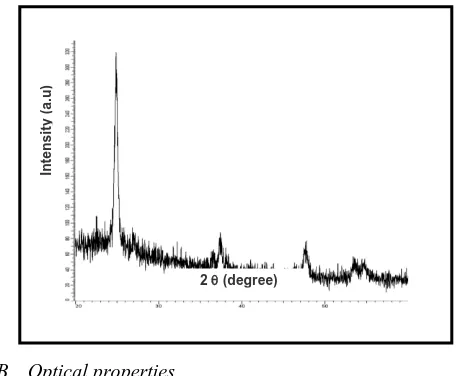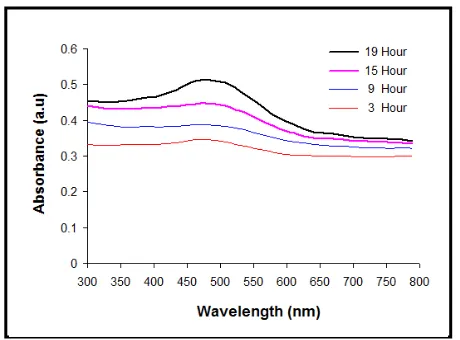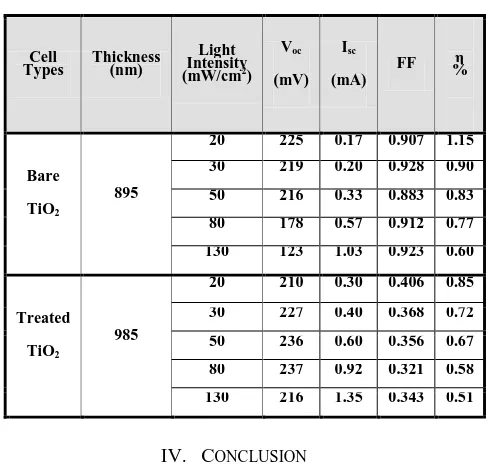International Journal of Emerging Technology and Advanced Engineering
Website: www.ijetae.com (ISSN 2250-2459,ISO 9001:2008 Certified Journal, Volume 4, Issue 10, October 2014)
686
Natural Yellow3 for Dye Sensitized Solar Cell
Nathera Abass Ali
1, Nagham Ali Hussein
21,2Department of Physics, Collage of Science, Baghdad University, Baghdad, Iraq
Abstract— The natural dye, Curcumin, was extracted from Curcuma longa using as a sensitizer in two types of dye sensitized solar cell (DSSC), and their characteristics were studied. The absorption spectrum of the dye solutions, as well as the wavelength of the maximum absorbance of the dye
loaded TiO2 film has been studied. The X-Ray diffraction
pattern of TiO2 film made with Doctor-Blading technique
shown that the grain size of TiO2 was equal to be 40 nm. The
electrical performances in terms of short circuit current, open circuit voltage and power conversion efficiency of cells were investigated.
Keywords— Curcumin dyes, nanoparticle, natural photosensitizers, photosensitizers, solar cells.
I. INTRODUCTION
The dye sensitized solar cell (DSSC) is a photovoltaic device for the conversion of visible light into electricity, based on the sensitization of wide band gap semiconductors. Light is absorbed by the dye sensitizer, which is anchored to the surface of a wide-band-gap semiconductor [1, 2 and 3]. Charge separation takes place at the interface via photoinduced electron injection from the dye into the conduction band of the nanocrystalline solids which are metal oxides, especially titanium dioxide. The performance of the cell mainly depends on the dye used as sensitizer. The absorption spectrum of the dye and the anchorage of the dye to the surface of TiO2 are
important parameters determining the efficiency of the cell [4]. Dye sensitized solar cells (DSSCs), a new type of solar cells; have attracted considerable attention due to their environmental friendliness, non toxicity and low cost of production [1, 2 and 5].
Curcumin dye extracted from rhizomatous herbaceous perennial plant of the ginger familywhich is Turmeric. It is native to tropical South Asia and needs temperatures between 20 °C and 30 °C [2, 6 and 7]. Its powder commonly used as a spice in curries and other South Asian and Middle Eastern cuisine, for dyeing, and to impart color to mustard condiments [2,8]. Curcumin can be used to test the alkalinity or acidity of foods. It turns yellow in an acidic food, and it turns red in an alkaline food. Curcumin is the active substance of Turmeric and is known as C.I. 75300, or Natural Yellow 3. The systematic chemical name is (1E, 6E)-1, 7-bis (4-hydroxy-3-methoxyphenyl)-1, 6 heptadiene-3, 5-dione [2, 9 and 10].
[image:1.612.365.527.268.405.2]Curcumin it can exist at least in two tautomeric, keto and enol as figure 1 shows, the keto form is preferred in solid phase and the enol form in solution. Its molecule has carbonyl and hydroxyl groups, which facilitate bind to the surface of TiO2 particles [2, 8 and 10].
Fig. 1 Chemical structures of Curcumin
II. EXPERIMENT METHODS
Work have prepared two types of dye sensitized solar cell, using natural dye which is Curcumin dye as photosensitizers, with nanocrystalline semiconductor oxide of TiO2 deposited and C- coated electrode as photo and
counter electrode respectively.
- First type cell without treated TiO2 photo electrode called
(bare TiO2 cell).
- Second type cell with treated TiO2 photo electrode called
(treated TiO2 cell).
A. Materials
Curcumin dye (C21H20O6) with MW (368.38 g/mol)
purchased from Fluka company (Switzerland), conductive glass plate FTO (7 ohm/sq) purchased from Solaronix company (Switzerland), TiO2 anatase nanopowder less than
50 nm grain size, with purity 99.8% (China), acetone pure from Medex (United kingdom), PEG from Himedia with MW (20.000 g/mol) (India), acetyleacetone from Riedel de
Haen AG Seelz-Hnnover (Germany), Titanium tetra chloride from Fluka (Switzerland), all other solvent and the chemical employed for the experimental were of laboratory grade chemicals.
Curcumin keto form
International Journal of Emerging Technology and Advanced Engineering
Website: www.ijetae.com (ISSN 2250-2459,ISO 9001:2008 Certified Journal, Volume 4, Issue 10, October 2014)
687
B. Preparation of TiO2 Photo Electrode
1- Preparation of Bare TiO2 Photo Electrode: The
photo electrode was prepared by depositing TiO2 film on
the conducting glass FTO. Prior to the film deposition the glass substrate was cleaning by using denatured alcohol such as ethyl alcohol (purity 96%), and left to dry in air. The edges of the conductive glass were then masked with a scotch tape to give an active area of 1.5 cm2 and to control the film thickness as well as to provide uncoated area for electrical contact. The TiO2 paste was prepared by the
incremental addition of 1.6 ml of de-ionized water and 0.02 ml acetylacetone to 1 g of TiO2 powder and 20 wt% (with
respect to TiO2 wt) of PEG (Poly ethylene glycol MW
20,000) was added as a binder, then grinding for 30 min. The TiO2 paste was spread uniformly on the conducting
side of substrate by Doctor-Blading technique [11, 16 and 4], then left it dried at room temperature for approximately 7 min to reduce the surface irregularities. The TiO2 layer
was sintered for 30 min at 450 ºC, and then allowed cool slowly at room temperature, thereafter dipped into the Curcumin dye solution 10-3 M for 19 hour in a dark place. The substrate was rinsed with organic solvent like acetone and then left to dry and immediately used in mounted cells.
2- Preparation of Treated TiO2 Photo Electrode:
The
treated electrode was prepared by using the same method for preparation bare TiO2 but when the TiO2 past sintered
and left to cool slowly at room temperature, then immersed in a 0.1M HCl solution for an hour and then washed with de-ionized water and dried the sides by cotton swab. Now the device was kept in TiCl4 solution for an hour, rinsed
with de-ionized water, after that TiO2 coated FTO substrate
was dipped into the Curcumin dye solution 10-3 M for 19 hour in a dark place. The substrate was rinsed with organic solvent like acetone. Thereafter they were left to dry and immediately used in mounted cells. This method is repeated with changing the concentration of dye. By illuminating the cells with a light source, the current, voltage, power conversion efficiency across each individual cell can be measured. The power conversion efficiency (η) of the solar cell devices were calculated by using the values of open circuit photovoltage (Voc), short circuits
photocurrent (Isc), fill factor (FF), and the power of incident
light (Pin). The power conversion efficiency (η) defines as
[4, 12 and 13].
in o u t
P P
in oc sc
P V FF
I
sc
oc I
V I V FF
. . max
max
Where:
η = power conversion efficiency of solar cell (%) I sc = solar cell short circuit photocurrent (A)
Voc = solar cell open circuit photovoltage (V)
FF = fill factor of the solar cell, it is the ratio of the maximum output power from the solar cell to the theoretical maximum power. Its value is always less than unity.
Pin = power of incident light (W)
Vmax = maximum solar cell photovoltage (V)
I max = maximum solar cell photocurrent (A)
III. RESULT AND DISCUSSION
A. Structural Properties
1- X-Ray Diffraction Patterns:
Figure 2 shows the XRD patterns of TiO2 film indicate the crystalline structure of its.
The diffraction peaks at 2 (25o, 38o, 48o, 55o) confirms that TiO2 anatase nanostructure with high purity and grain
[image:2.612.326.554.391.579.2]size equal to be 40 nm.
Fig. 2 XRD pattern of TiO2 film
B. Optical properties
1- UV-Vis Absorption Spectroscopy: Figure 3 Shows the effect of dye solution concentration on treated TiO2 and
notice 10-3 M concentration of dye solution is the best concentration to increasing absorbance for treated TiO2.
2 (degree)
In
te
n
s
it
y
(
a
.u
International Journal of Emerging Technology and Advanced Engineering
Website: www.ijetae.com (ISSN 2250-2459,ISO 9001:2008 Certified Journal, Volume 4, Issue 10, October 2014)
[image:3.612.64.291.131.308.2]688
Fig. 3 Effect of dye solution concentration on treated TiO2
Figure 4 shows the effect of immersion time in dye solution with concentration 10-3M on treated TiO2. It is
clearly seen 19 hour is the best immersion time in dye solution to increasing absorbance for treated TiO2.
Fig. 4 Effect of immersion time in dye solution on treated TiO2
Figure 3 and 4 shows that 10-3 M concentration of dye solution and 19 hour immersion time in it are the optimum condition to increase the absorbance of treated TiO2.
Figure 5 shows the absorption spectrum of photo electrodes (bare TiO2, treated TiO2) and Curcumin dye
were recorded by using UV-Vis spectrophotometer. Figure shows the increasing absorbance for bare TiO2 and treated
TiO2 also shifting to the long wavelength of visible light
[image:3.612.331.568.133.299.2]which is evidence and indicate decreasing the energy gab of TiO2 by sensitized with Curcumin dye as show in table I.
[image:3.612.54.284.373.543.2]Fig.5 Absorption spectrum of photo electrodes (bare TiO2, treated TiO2), Curcumin dye and pure TiO2
Table I shows the decreasing in Eg for treated TiO2 more
than bare TiO2 that interpreted the increasing of absorbance
and shifting to long wave of visible light for treated TiO2
larger than bare TiO2.
TABLE I
ENERGY GABS OF ALL PREPARED TIO2 SAMPLE
Sample Energy Gap (eV)
TiO2 (pure TiO2) 3.2
Dye 2.3
TiO2 dye (bare TiO2) 2.5
TiO2 HCl dye 2.4
TiO2 HCl TiCl4 dye (treated TiO2) 2.0
C. Electrical (photovoltaic) properties
Figure 6 shows the directly proportional of short circuit current with intensity of light for two types of DSSC. It is clearly appear the current in treated TiO2 cell greater than
bare TiO2 cell that is attributed to increase the thickness of
film which led to increase current that is related with increase the electron injection from exited dye to the conduction band of TiO2. This results in agreement with
[image:3.612.326.563.402.486.2]International Journal of Emerging Technology and Advanced Engineering
Website: www.ijetae.com (ISSN 2250-2459,ISO 9001:2008 Certified Journal, Volume 4, Issue 10, October 2014)
[image:4.612.59.283.129.299.2]689
Fig. 6 Short circuit current curves for two types of constructed DSSC
Figure 7 shows the open circuit voltage changing with the intensity of light for two types of DSSC, also it is clearly seen the voltage for treated TiO2 cell greater than
bare TiO2 as discussed in previous section.
[image:4.612.325.552.132.302.2]
Fig. 7 Open circuit voltage curves for two types of DSSC
Figure 8 shows the comparison between the power conversion efficiency for two types of DSSC (bare TiO2,
treated TiO2). As it is clearly appear the power conversion
efficiency for bare TiO2 cell larger than treated TiO2 cell at
different intensity of light. This is interpreted as clear from table II the current increase with increasing film thickness while fill factor and efficiency decrease, this result in agreement with [14, 15 and 16].
The efficiency 1.15% for bare TiO2 cell achieved solar
power conversion efficiency which is the highest efficiency obtained among all solar cell sensitized by Curcumin dye as comparison with previous literature of [1, 2, 4 and 10].
Fig. 8 The comparison between the power conversion efficiency for two types of DSSC
Table II Represents the performance of the DSSC in terms of short circuit current (Isc), open circuit voltage
(Voc), fill factor (FF) and power conversion efficiency (η)
for two types of DSSC [(bare TiO2 and treated TiO2) photo
electrode] sensitized with Curcumin dye, under different intensity of light, for active area 1.5 cm2.
TABLE II
PHOTOVOLTAIC PROPERTIES FOR TWO TYPES OF DSSC(BARE TIO2
AND TREATED TIO2) PHOTO ELECTRODE SENSITIZED WITH CURCUMIN
DYE
IV. CONCLUSION
This work has constructed two types of dye solar cell sensitized with Curcumin dye and a comparison made between their optical and electrical properties concluded the following:
Cell
Types Thickness (nm)
Light Intensity (mW/cm2)
Voc
(mV) Isc
(mA)
FF % η
Bare
TiO2
895
20 225 0.17 0.907 1.15 30 219 0.20 0.928 0.90 50 216 0.33 0.883 0.83 80 178 0.57 0.912 0.77 130 123 1.03 0.923 0.60
Treated
TiO2
985
20 210 0.30 0.406 0.85
[image:4.612.57.284.371.533.2] [image:4.612.327.571.435.670.2]International Journal of Emerging Technology and Advanced Engineering
Website: www.ijetae.com (ISSN 2250-2459,ISO 9001:2008 Certified Journal, Volume 4, Issue 10, October 2014)
690
1- Increasing absorbance for bare TiO2 film and treated
TiO2 film also shifting to the long wavelength by
sensitized with Curcumin dye.
2- Absorbance and shifting to long wave of visible light for treated TiO2 film larger than bare TiO2 film.
3- Decreasing energy gab for treated TiO2 film sensitize
with Curcumin dye more than bare TiO2 film.
4- Concentration 10-3 M of dye solution and 19 hour immersion time in it are the optimum condition to increase the absorbance of treated TiO2 film and
shifting to long wave length of visible light.
5- Electrical parameters (voltage, current) for treated TiO2 cell larger than bare TiO2 cell.
6- Maximum value of current for two types of cell obtained at 130 mW/cm2 intensity of light and decrease with decreasing this intensity.
7- Power conversion efficiency for bare TiO2 cell larger
than treated TiO2 cell at different intensity of light and
the maximum value for two types obtained at 20 mW/cm2 intensity of light.
REFERENCES
[1] Kim, H., Kim, D., Karthick, S.N., Hemalatha, K.V., Justin R. C., ok, S., Choe, Y., (2013), Curcumin Dye Extracted from Curcuma longa L. Used as Sensitizers for Efficient Dye Sensitized Solar Cells, International Journal of electrochemical science, vol. 8, pp. 8320-8328.
[2] Al-Bat’hi, S. A. M., Alaei, I., Sopyan, I., (2013), Natural Photosensitizers for Dye Sensitized Solar Cells, International journal of renewable energy research, vol. 3, no. 1, pp. 138-143. [3] Kelvin, O. O., and Ekpunobi, (2012), Fabrication and
Characterization of Dye Sensitized Solar Cell Using Anarcardium Occidentale Sensitizer, Advances in Applied Science Research, vol. 3, no. 5, pp. 3390-3395.
[4] Moustafa, K. F., Rekaby, M., El Shenawy, E. T., Khattab, N.M., (2012), Green Dyes as Photosensitizers for Dye Sensitized Solar Cells, Journal of Applied Sciences Research, vol. 8, no. 8, pp. 4393-4404.
[5] Aohan, Y., (2011), Coating Titanium Dioxide and Solar Cell, Saimaa University of Applied Sciences, Imatra.
[6] Buddee, S., Wongnawa, S., (2012), Enhanced Photocatalytic Degradation of Dyes under Visible Light Irradiation by Curcumin Doped TiO2 Mixture, Pure and applied chemistry international
conference PACCON.
[7] Mohammed, A. S., Majeed, M. R., Jasim, H. A., (2012), Extraction of Curcumin Pigment and Study Its Efficiency in Dyeing of Scoured Cotton Fabric and as Antibacterial Agent, Iraq journal of science, vol. 53, no. 2, pp. 308-315.
[8] Zyoud, A., Hilal, H., (2013), Curcumin Sensitized Anatase TiO2
Nanoparticles for Photodegradation of Methyl Orange With Solar Radiation, Published at: IEEE digital library also in The 1st International Conference & Exhibition on the Applications of Information Technology in Developing Renewable Energy Processes and Systems (IT-DREPS 2013) Le Meridian Hotel, Amman-Jordan. [9] Zihlman, J., (2006), Laboratory Chemical and Analytic Reagents,
Inc. Fluka, Switizerland.
[10] Sorachoti, K., (2006), Crude Dyes Extracted from Plants and Monascus Rice Cultures as Sensitizers in Solid-State Dye sensitized Solar Cells, M. Sc. Thesis, Kasetsart University, Thailand, pp. 5,6,21 and 25.
[11] Martineau, D., (2012), Dye Solar Cells for Real (The Assembly Guide for Making Your Own Solar Cells), © 2012 Solaronix SA, Rue de l'Ouriette 129, CH-1170 Aubonne, Switzerland
[12] Dissanayake, M.A.K.L., Dharmadasa, I.M., Weerasooriya, R., Senadeera, G.K.R., Bandara, J.M.S., (2011), Solar Asia– 2011, International Conference on Solar Energy Material, Solar Cells and Solar Energy Application, jointly organized institute of fundamental studies Kandy, Sri Lanka and national science foundation Colombo, Sri Lanka, pp. 213-220.
[13] Kusumawardani, C., Indriana, K., Narsito, (2010), Synthesis of Nanocrystalline N-Doped TiO2 and Its Application on High
Efficiency of Dye-Sensitized Solar Cells, science journal Ubon Ratchathani University, vol. 1, no. 1, pp. 1-8.
[14] Wei, M., Konishi, Y., Zhou, H., Yanagida, M., Sugihara, H., Arakawa, H. , (2006), Highly Efficient Dye-Sensitized Solar Cells Composed of Mesoporous Titanium Dioxid, Journal of Materials Chemistry, vol.16, no. 13, pp. 1287-1293.
[15] Alwan, D. B. , (2013), Preparation Dye Sensitized Solar Cell with Tracking System, M.Sc. Thesis, University of Baghdad, Iraq, pp. (20-21).



